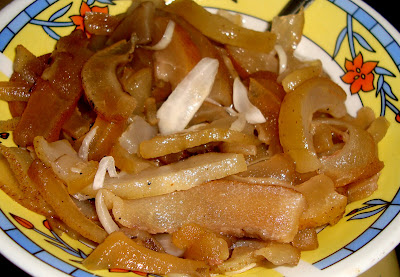Dr Abe V Rotor
Living with Nature School on Blog
1. This is a favorite dish of Ilocanos known as “jumping salad.”
In Paaralang Bayan sa Himpapawid (school-on-the-air) program, five callers phoned to give their answers. Except one who said he learned about this rare dish from a friend, the callers apparently Ilocanos, said they have actually tasted jumping salad.
Newly caught juvenile shrimps, promptly dressed with tomato or calamansi and a dash of salt. Pick them up individually by the head, put it into the mouth in reverse, severe the rostrum (unicorn) and antennae with the teeth to avoid injury. It is the kicking in the mouth that gives this unique dish its name jumping salad. (Photo acknowledgement, Internet)
This dish is prepared from newly caught small to medium shrimps from the estuaries and rivers, and while they are still very much alive are served right there and then with calamansi and salt, momentarily agitating the ill-fated creatures.
Pronto! The shrimps, on removing the cover, frantically jump out of the plate, save the dazed ones. You should be skillful in catching them from the table (and even on the floor) deftly picking them by the head, taking caution so as not to get hurt by their sharp rostrum. You can imagine the danger you face as the creature makes its last attempt to escape. You must get a firm hold before putting the struggling creature into your mouth, tail first and quickly bite off the head, severing the sharp dagger in your hold. The creature wriggles in the cave of your mouth and you can actually feel its convulsion fading as it undergoes the initial process of digestion.
Being an Ilocano myself, eating jumping salad is an adventure and rarely do you experience having one nowadays, unless you are living near the sea, river or lake, or a good friend brings live shrimps to town in banana stalk container to keep them alive.
Try jumping salad. It’s one for the Book of Guinness.~
The practice of gathering the blood while dressing the chicken is now rare. Well, it is because we get our chicken from the supermarket or grocery already dressed or frozen. But in the good old days, chicken blood is mixed with glutinous rice (malagkit).
This is done by getting just enough rice, wash it quickly in a small shallow plate, and blood directly coming from the chicken is mixed and allowed to settle, solidifying in a minute or two. It is easily dislodged from the plate when it is time to cook it with the chicken when cooking tinola (stew).
We kids would automatically pick the solid rice-blood even while the stew is still in the pot, but our elders would rather divide it among ourselves to settle the issue. ~
Acknowledgement: Internet image of live shrimp



































.jpg)













